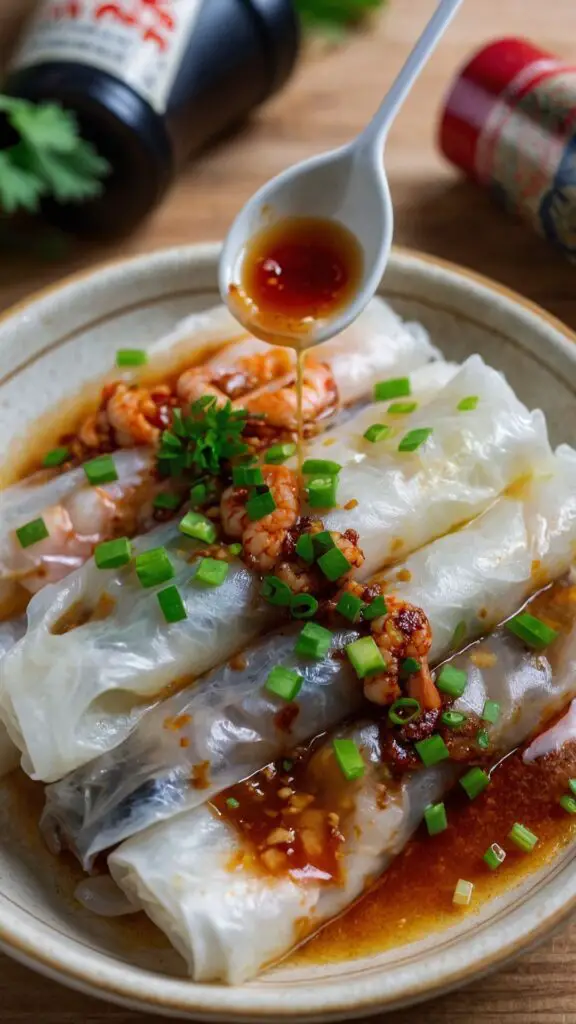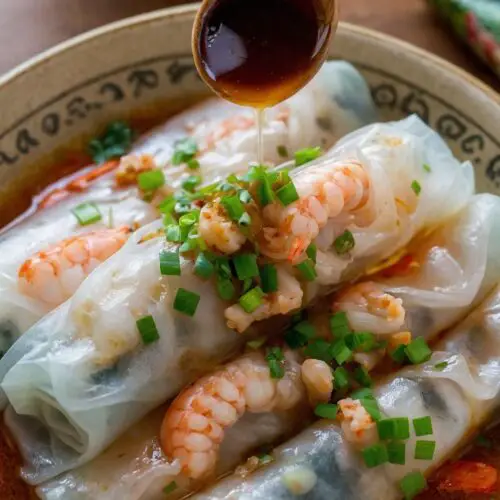Shrimp Rice Noodle Rolls (Cheung Fun) – Culinary Chase
If you’re anything like me, you appreciate a dish that feels like a hug on a plate. Shrimp rice noodle rolls, known as Cheung Fun, are exactly that. This delightfully chewy, savory treat not only satisfies your taste buds but also feeds your soul.
But before we dive into the nitty-gritty of how to make these rolls, let’s chat about what you might serve alongside this dish to elevate your culinary experience.
What Pairs Well with Shrimp Rice Noodle Rolls
1. Dipping Sauces: A variety of dipping sauces like soy sauce with garlic or a spicy chili sauce can awaken those flavors even more.
2. Pickled Vegetables: The crunch and tang of pickled cucumbers or carrots balance the softness of the rolls and add a refreshing bite.
3. Herb Salad: A simple herb salad with mint and cilantro offers brightness and can help cut through the richness of the rolls.

Imagine strolling through a vibrant Asian market, the air filled with the smell of street food and the sounds of sizzling woks. You can almost taste the buttery shrimp nestled in silky rice noodles, drizzled with a sweet-savory sauce. This is the world of Cheung Fun. It’s a beloved dish in dim sum restaurants and busy street vendors, but you can recreate it right in your kitchen. Today, I’ll guide you through making shrimp rice noodle rolls, sharing my thoughts, experiences, and expertise. Grab your apron; let’s get rolling!
What is Shrimp Rice Noodle Rolls Cheung Fun?
Cheung Fun is a type of Cantonese rice noodle roll. It’s made with a delicate rice flour batter that transforms into a thin sheet before being filled with various ingredients like shrimp, pork, or vegetables.
After being rolled up, the noodles are usually served steamed and topped with a glossy sauce. This dish isn’t just visually appealing; its flavors and textures are exhilarating. One bite and you’ll understand why it’s so popular!
You will also like the following Main Courses recipes!
Why This Recipe Works
1. Authentic Flavor: The harmony of flavors in the sweet-savory sauce gives the dish an authentic taste reminiscent of your favorite dim sum spot.
2. Chewy Texture: The use of rice and tapioca flour creates that perfect chewy texture that rice noodle rolls are famous for.
3. Quick Prep Time: Surprisingly, this dish comes together fairly quickly. If you’re in a hurry, this is your go-to recipe!
4. Nutrient-Packed: With fresh shrimp and a low-fat sauce, this recipe is lighter yet satisfying. You can enjoy a delicious meal without guilt.
Ingredients You’ll Need To Make This Dish
For the Prawn Filling:
- 2 tablespoons chopped spring onions (green parts only)
- 14 fresh prawns, sliced lengthwise into halves
- ½ teaspoon grated ginger
- 1 teaspoon sea salt
- 1 teaspoon finely ground white pepper
For the Rice Roll Batter:
- ½ teaspoon sesame seeds
- 1 teaspoon fine salt
- ¼ cup tapioca starch
- ½ cup superfine rice flour
- 1½ cups filtered water
For the Sweet-Savory Sauce:
- 1 tablespoon oyster sauce
- 1 tablespoon light soy sauce
- 3 tablespoons warm water
- 1 tablespoon dark soy sauce
- 1 tablespoon granulated sugar
- 1 tablespoon toasted sesame oil

How To Make Shrimp Rice Noodle Rolls Cheung Fun
Step 1: Prepare the Prawn Filling
Start by mixing the chopped spring onions, sliced prawns, grated ginger, salt, and white pepper in a bowl. This simple filling is packed with flavor. Let it sit while you prepare the batter.
Step 2: Make the Rice Roll Batter
In a mixing bowl, combine the tapioca starch, rice flour, salt, and sesame seeds. Gradually stir in the water until you get a smooth batter. It should be somewhat liquid texture but not too watery.
Step 3: Prepare for Steaming
Spread a thin layer of batter on a lightly oiled heat-proof plate or steaming dish. Make sure the layer is even.
Step 4: Steam the First Layer
Place the plate in a steamer and steam for about 3-5 minutes until the batter has set and turned translucent. You’ll know it’s ready when it appears slightly shiny.
Step 5: Add the Filling
Once the first layer is steamed, place a portion of the prawn filling across the center of the noodle. Gently roll it up from one end to the other. Be gentle; you want to keep it intact.
Step 6: Repeat the Process
Remove the plate from the steamer, oil it lightly again, and repeat with the remaining batter and filling. It might take a bit of practice, but the rolls don’t have to be perfect—they just have to be delicious!
Step 7: Make the Sauce
While the last batch of rolls are steaming, whisk together the oyster sauce, light soy sauce, dark soy sauce, sugar, and sesame oil. Add warm water to adjust the consistency.
Step 8: Serve
Once all the rolls are done, slice them into bite-sized pieces, drizzle the sauce on top, and serve hot.
Tips & Tricks
– Lightly Oil Everything: Before steaming, always oil your steaming trays and plates to prevent sticking.
– Batch It Up: Make a large batch and freeze some for future meals; you’ll thank yourself later!
– Watch the Heat: Keep an eye on the steaming time; overcooking can make the rolls gummy.
– Play with Fillings: Don’t hesitate to experiment with fillings. Chicken, mushrooms, and veggies can play nicely too!
– Presentation: For a fancy twist, top with fried garlic bits or sesame seeds before serving.
Nutrition Information
Shrimp rice noodle rolls are not only a delightful meal but also a nutritious option. They are relatively low in calories and high in protein due to the shrimp. One serving typically contains around 210 calories, 10 grams of protein, and minimal fat, making it a balanced choice.
How Do You Store The Leftovers?
If you happen to have leftovers (which is rare in my experience), you can store them in an airtight container in the fridge for up to two days. Just reheat them in the steamer or microwave, and they’re good to go!

What Sides Would Complement Shrimp Rice Noodle Rolls Cheung Fun?
1. Hot and Sour Soup: A warm bowl of hot and sour soup adds a great contrast with its tangy and spicy notes.
2. Chinese Broccoli with Oyster Sauce: This simple dish adds crunch and nutrition, making it a great sidekick to your noodle rolls.
3. Steamed Dumplings: Steamed dumplings, with any filling you prefer, can pair beautifully alongside Cheung Fun, making for a more extensive meal.
What Alternatives Can You Use for the Ingredients If They Are Not Present in Your Kitchen?
1. Prawns: If you don’t have prawns, any mild white fish works well. Just make sure to adjust cooking times.
2. Rice Flour: You can substitute with all-purpose flour, but the texture will change, making it less chewy.
3. Oyster Sauce: If you want to keep it vegetarian, use a mushroom sauce instead. It adds a similar umami flavor.
4. Sesame Oil: You can use any neutral oil if you don’t have sesame oil. Just know it’ll lack that nutty flavor.

Shrimp Rice Noodle Rolls (Cheung Fun)
Equipment
- Bowl
- Cup
Ingredients
For the Prawn Filling:
- 2 tablespoons chopped spring onions green parts only
- 14 fresh prawns sliced lengthwise into halves
- ½ teaspoon grated ginger
- 1 teaspoon sea salt
- 1 teaspoon finely ground white pepper
For the Rice Roll Batter:
- ½ teaspoon sesame seeds
- 1 teaspoon fine salt
- ¼ cup tapioca starch
- ½ cup superfine rice flour
- 1½ cups filtered water
For the Sweet-Savory Sauce:
- 1 tablespoon oyster sauce
- 1 tablespoon light soy sauce
- 3 tablespoons warm water
- 1 tablespoon dark soy sauce
- 1 tablespoon granulated sugar
- 1 tablespoon toasted sesame oil
Instructions
Step 1: Prepare the Prawn Filling
- Start by mixing the chopped spring onions, sliced prawns, grated ginger, salt, and white pepper in a bowl. This simple filling is packed with flavor. Let it sit while you prepare the batter.
Step 2: Make the Rice Roll Batter
- In a mixing bowl, combine the tapioca starch, rice flour, salt, and sesame seeds. Gradually stir in the water until you get a smooth batter. It should be somewhat liquid texture but not too watery.
Step 3: Prepare for Steaming
- Spread a thin layer of batter on a lightly oiled heat-proof plate or steaming dish. Make sure the layer is even.
Step 4: Steam the First Layer
- Place the plate in a steamer and steam for about 3-5 minutes until the batter has set and turned translucent. You’ll know it’s ready when it appears slightly shiny.
Step 5: Add the Filling
- Once the first layer is steamed, place a portion of the prawn filling across the center of the noodle. Gently roll it up from one end to the other. Be gentle; you want to keep it intact.
Step 6: Repeat the Process
- Remove the plate from the steamer, oil it lightly again, and repeat with the remaining batter and filling. It might take a bit of practice, but the rolls don’t have to be perfect—they just have to be delicious!
Step 7: Make the Sauce
- While the last batch of rolls are steaming, whisk together the oyster sauce, light soy sauce, dark soy sauce, sugar, and sesame oil. Add warm water to adjust the consistency.
Step 8: Serve
- Once all the rolls are done, slice them into bite-sized pieces, drizzle the sauce on top, and serve hot.
Notes
– Batch It Up: Make a large batch and freeze some for future meals; you’ll thank yourself later!
– Watch the Heat: Keep an eye on the steaming time; overcooking can make the rolls gummy.
– Play with Fillings: Don’t hesitate to experiment with fillings. Chicken, mushrooms, and veggies can play nicely too!
– Presentation: For a fancy twist, top with fried garlic bits or sesame seeds before serving.
Nutrition
Frequently Asked Questions
1. Can I make these rolls in advance?
Absolutely! They can be made a day ahead. Just store them in an airtight container and steam them before serving.
2. Can I use frozen shrimp?
Yes, frozen shrimp is great. Just ensure you thaw and drain it properly.
3. Who invented Cheung Fun?
This dish has deep culinary roots in Cantonese cuisine and has been enjoyed for centuries, making it hard to pinpoint one inventor.
4. Is Cheung Fun gluten-free?
This dish contains no gluten if you use gluten-free rice flour. Always check the labels to be sure.
5. What toppings can I use?
Feel free to add toppings like crispy fried garlic, spring onions, or sliced green chili for additional flavor.
6. How do I know if my rolls are cooked?
Cooked rolls will be opaque and slightly firm. If they are mushy, they likely have been overcooked.
Conclusion
Making shrimp rice noodle rolls (Cheung Fun) is not just about cooking; it’s about creating a piece of culinary art that delights the senses. Using fresh ingredients enhances both flavor and nutrition. Whether you enjoy them for breakfast, lunch, or dinner, these rolls bring joy to the table. Embrace the cooking process, invite friends over, and serve these rolls with a smile. After all, sharing good food is one of the best parts of life. So, gather your ingredients, roll up those sleeves, and get ready to impress yourself and your loved ones!
